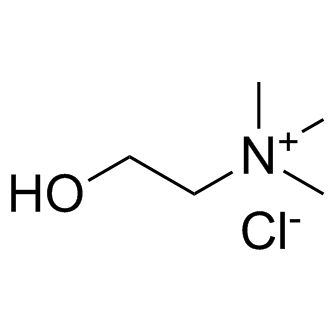Description
| M. WT | 139.62 |
|---|---|
| Structure | HOCH2CH2N(CH3)3Cl |
| FORMULA | C5H14ClNO |
| SOLUBILITY | DMSO |
| PURITY | >98% |
| STORAGE | at -20°C 3 years Powder |
| CAS NO. | 67-48-1 |
| SMILES | C[N+](C)(C)CCO.[Cl-] |
General description
2-Hydroxyethyl trimethylammonium chloride; 2-hydroxy-N,N,N-trimethylethanaminium chloride; 2-hydroxy-N,N,N-trimethylethanaminium chloride hydrochloride
Physical properties: Dry flowable powder product is yellow and particles having strong hygroscopicity, slightly fishy smell.
Particles: 20 mesh
Packing: 25 kg / bag
Storage: Put in a cool, dry place, kept under seal.
Choline is a constituent of sphingomyelin and lecithin. It is a precursor of acetylcholine. Choline plays a vital role in methyl group metabolism, carcinogenesis and lipid transport. Choline deficiency is associated with fatty liver.[1] It maintains cell structural integrity and cell signalling.[2] Choline is implicated in the synthesis of phospholipids. It acts as a potent biomarker for ischemic heart disease.[3]
Application
Choline is an essential nutrient, commonly grouped with the B complex vitamins, that plays key roles in many biological processes.
The enzymatic activities of butyrylcholinesterase (BChE) and paraoxonase 1 (PON1), two serum enzymes synthesized by the liver and related with inflammation, were decreased in a sepsis animal model injected with LPS. Choline chloride administered intravenously at 20 mg/kg body weight prevents the LPS-mediated decreases in the activities of these two enzymes .
Animal Feed
Natural feedstuffs do not contain a consistent amount of choline, nor is the amount present predictably bioavailable due to variations in crop growth conditions (see reference 5). Because livestock have a physiological need for choline, manufacturers add it to their animal feeds in the form of choline chloride. They typically add choline chloride as a 70 percent solution to cereals to enhance the nutrient supply for poultry, pigs and other livestock. Choline chloride helps prevent liver enlargement in chicks, as well as perosis, a condition in poultry that can lead to leg bone deformity. Choline specifically acts to prevent fatty liver syndrome and helps in the formation of the neurotransmitter, acetylcholine, maintaining proper nervous system functioning.
Human Development
In your body, choline is an essential nutrient. The structural integrity of cell membranes–as well as cell signaling, neurotransmission, muscle function and fat transport–all require choline. Choline is also a source of methyl groups, a specific chemical group containing one carbon atom and three hydrogen atoms. Methyl groups are required for a variety of chemical reactions in your body. During fetal development, choline influences stem cell proliferation and apoptosis, also known as programmed cell death, which is essential for brain and spinal cord structure and function, decreasing neural tube defects and increasing memory function. You can synthesize choline directly in your body, but humans also often obtain it through their diets. Dietary intake of choline needs vary among individuals. Men and postmenopausal women experience signs of organ dysfunction with insufficient dietary choline, while less than half of premenopausal women develop such signs
Choline is customary classified as a vitamin. It belongs to the family of water soluble B-vitamins. It was formerly known as the vitamin B4.
Like other vitamins, it plays a significant role in nutrition, but its daily requirement seems to be hundreds of times greater than that of other vitamins.
Choline has three essential metabolic functions:
- As a constituent of lecithin, it is important for the construction of the cellular membrane and for the transport of lipids from the liver – thus preventing fat accumulation in that organ.
- As a precursor in the synthesis of the neurotransmitter acetylcholine, interacting in muscle control.
- As a source of labile methyl groups, which are essential for numerous biological processes and therefore an important factor for healthy growth.
In the compound feed sector, choline is generally added as the hydrochloric acid salt choline chloride. It is widely incorporated in feed for poultry, pigs, crustaceans, fish and calves, as well as being an essential additive to pet food.
Choline chloride is produced synthetically from trimethylamine, manufactured in-house by Eastman. The complete production process is operated under strict conditions compliant with ISO 9000 and HACCP certification. Addition levels vary by species, but also depend on age, feed composition, environmental stress, and breed. The required addition level is the difference between the requirements on the one hand and the levels of naturally available choline on the other hand. It is augmented with a safety margin, to cover up for variations of choline levels in natural feed ingredients.






